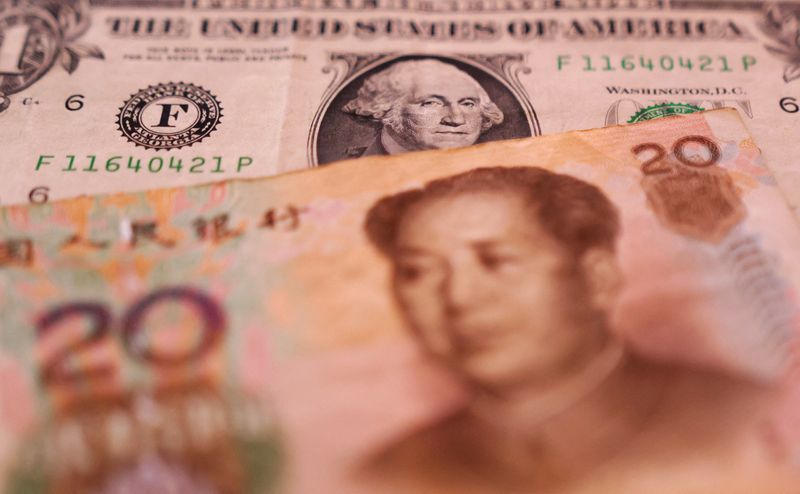Soft U.S. landing to free investor cash toward EMs -IIF
2023.06.14 11:44

© Reuters. U.S. Dollar and Chinese Yuan banknotes are seen in this illustration taken January 30, 2023. REUTERS/Dado Ruvic/Illustration
NEW YORK (Reuters) – The U.S. economy should avoid a recession this year while inflation will fall closer to target, implying “a positive outlook for capital flows to emerging markets,” a global banking trade group said in a Wednesday report.
Latin America as a whole is expected to be among foreign money’s favorite destinations among emerging markets (EMs), despite red flags from Argentina, according to the Institute of International Finance, with doubts about the cash pull from China and Turkey among others.
The IIF sees the U.S. economy growing 1% in 2023, which “coupled with a benign inflation view” of 3.1% annualized at the end of the year would provide fertile ground for offshore investment in developing countries.
Foreign capital inflows are forecast to rise while resident outflows are seen falling for the year, yielding net capital outflows of some $173 billion across EMs, compared to a $522 billion outflow in 2022, according to IIF estimates.
Excluding China, net capital flows are estimated at a $80 billion inflow this year after posting $221 billion in outflows in 2022.
Higher rates and tighter monetary policy across developed markets -of which the U.S. is the most important- usually bode ill for EMs as investors prefer the attractive and more secure returns in times of uncertainty, usually draining cash from less-developed nations.
But the bullish backdrop “is playing out in our high-frequency tracking of flows,” which have been “very strong” to EMs excluding China so far in the second quarter, the report said.
Investors are branching out as recent favorite China has been hurt by a stubbornly slow economic growth and importantly by the perception of political risk that made Russia uninvestable after its invasion of Ukraine early last year.
Net inbound foreign direct investment to China through all of 2023 is forecast to be at its lowest level in 18 years, the IIF said.
“This shift may be especially positive for Latin America, where global investors are now more willing to look past other issues.”
DRILLING DOWN
The report, limited to a 25-country universe, breaks out some regional and local forecasts.
Even as Argentina continues to delay needed reforms ahead of presidential elections in October, triggering a forecast for a $15 billion external financing gap, stronger policy frameworks in most of its major regional neighbors “should help sustain private capital flows to (Latin America) in the medium term.”
Over in Turkey, where recent cabinet and central bank announcements have triggered bullish market views on the direction of the recently reelected administration under Tayyip Erdogan, the IIF is cautious and optimistic: they don’t expect a “decisive pivot” to orthodox monetary policy until after municipal elections in 2024.
With that view they project sustained outflows from both foreigner and resident portfolios through the second half of the year, but expect those to be offset by FDI from friendly states “thanks mainly to President Erdogan’s close bilateral ties.”
Overall they see more tourism and fewer energy imports as the basis of a $30 billion replenishing of foreign exchange and gold reserves at the central bank.
Friendly relations of another kind could weigh on South Africa, where the IIF sees a risk of Western sanctions linked to government ties with Russia.
“In such a risk-off scenario, we project sizable net outflows of nonresident capital from South Africa, which we estimate could result in an external funding gap of around $28 billion.”
The IIF sees power supply as the main hurdle for more FDI toward infrastructure and growth projects, with only renewable energy taking the bulk of near-term investments.
Elsewhere in Africa, the IIF sees Egypt being forced to offer steep discounts as it looks to offload state-owned assets as part of a needed structural adjustment.
Key to this adjustment is “the adoption of a flexible exchange rate regime, something the (central bank) has much touted but has been wary of doing.”
Not far in Saudi Arabia the beat is up, with foreign capital inflows seen jumping four-fold to $44 billion this year compared to last as foreign currency bond issuance balloons, while flows to equities are also expected to rise.
“Preliminary data for the first five months of this year shows that FX bond issuance has already surpassed that of the entirety of last year.”







